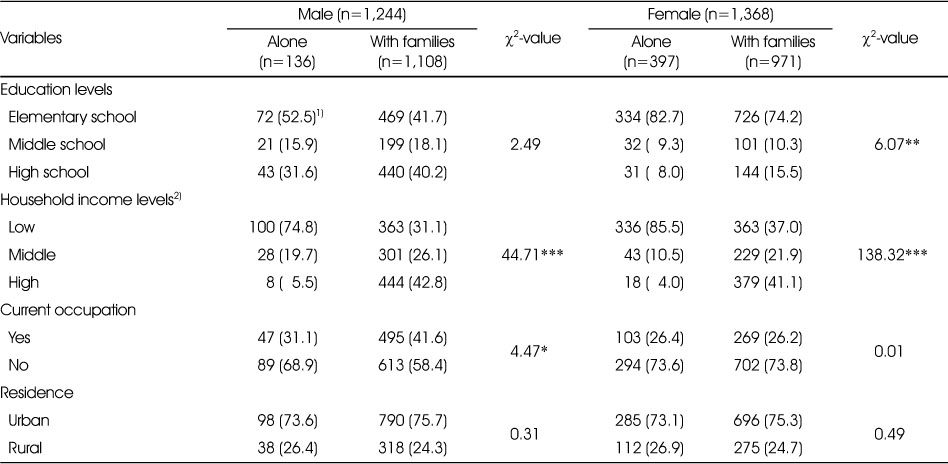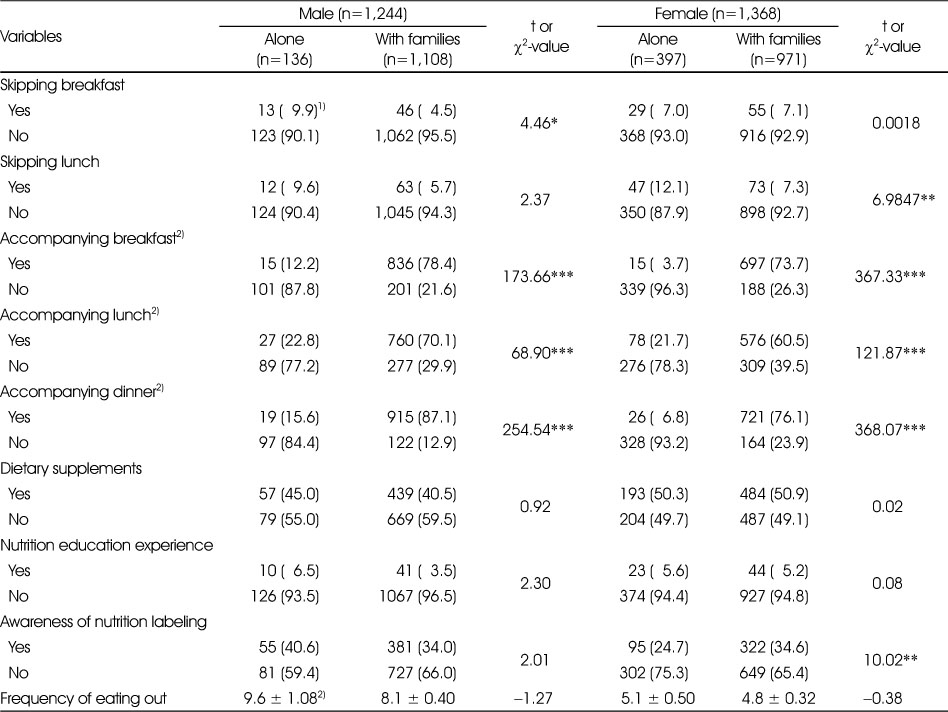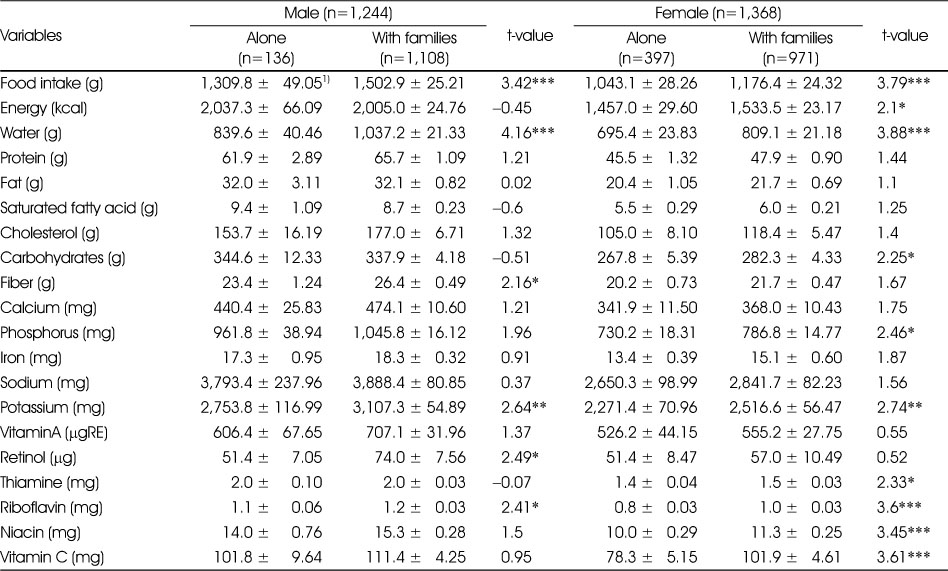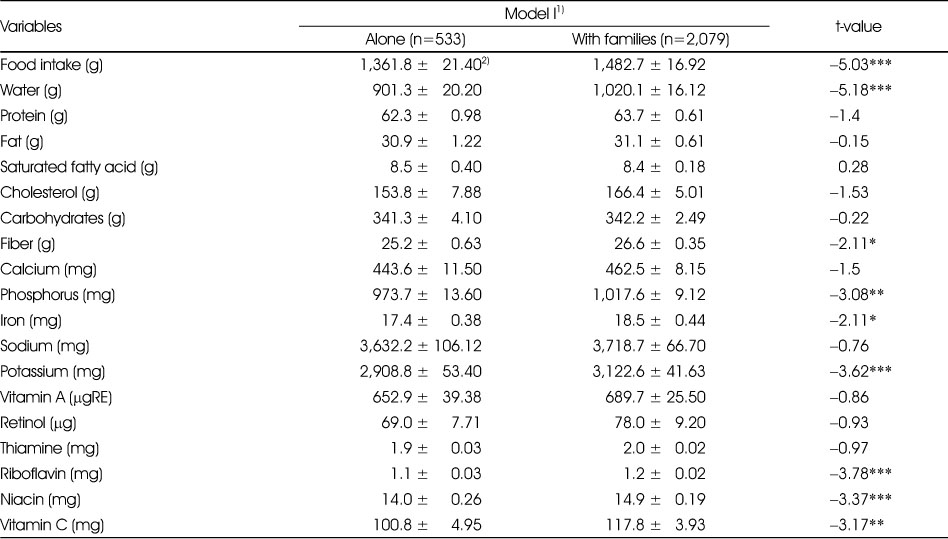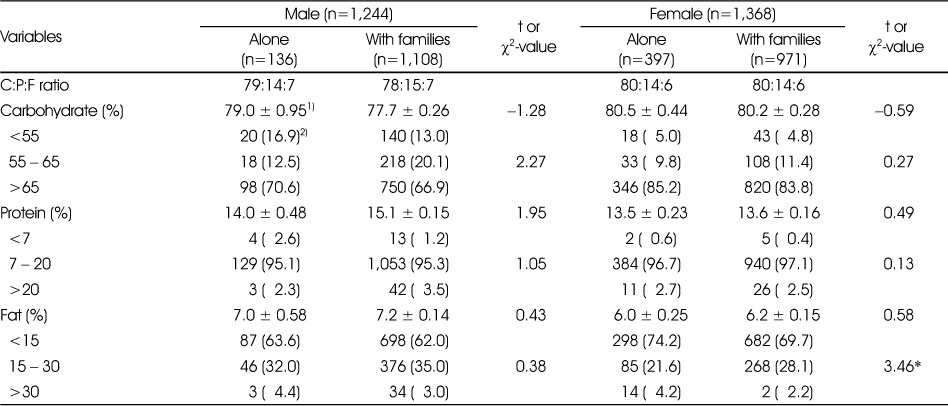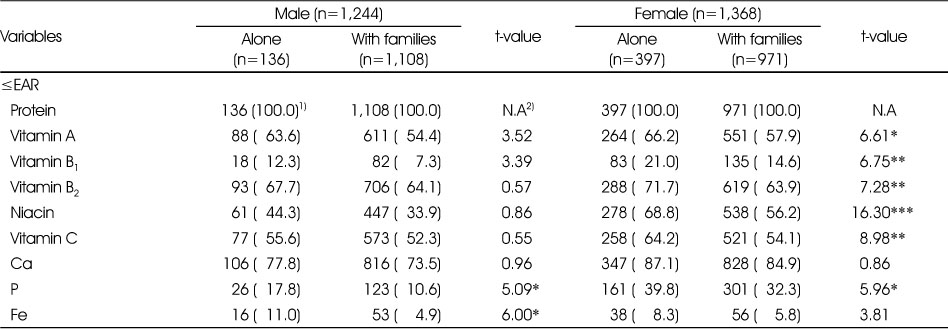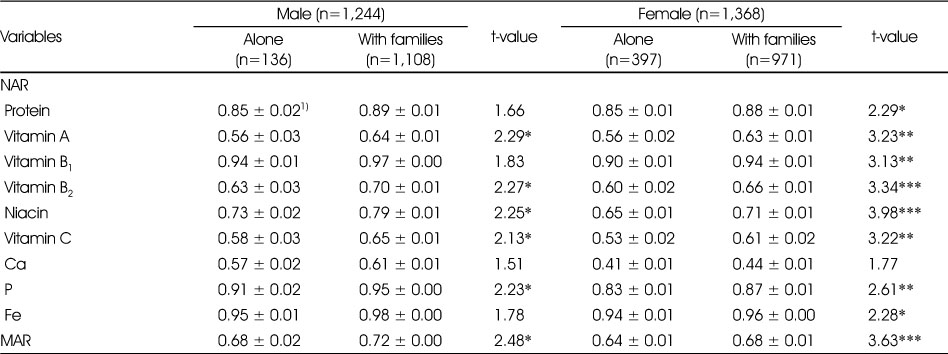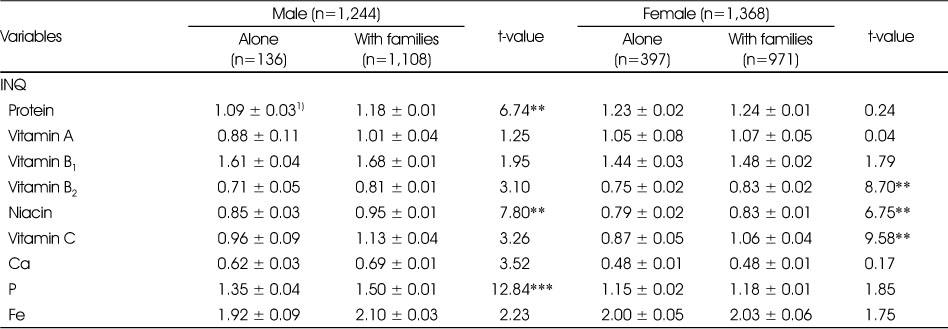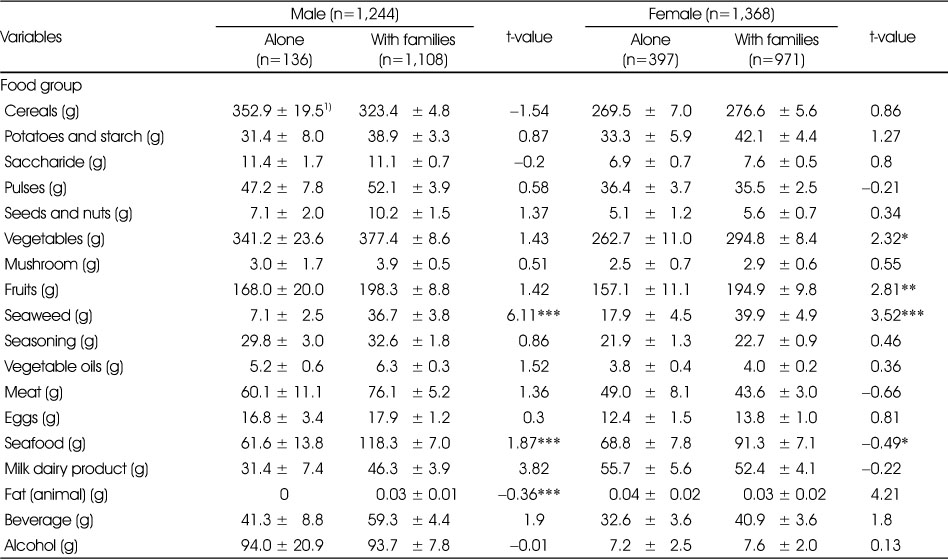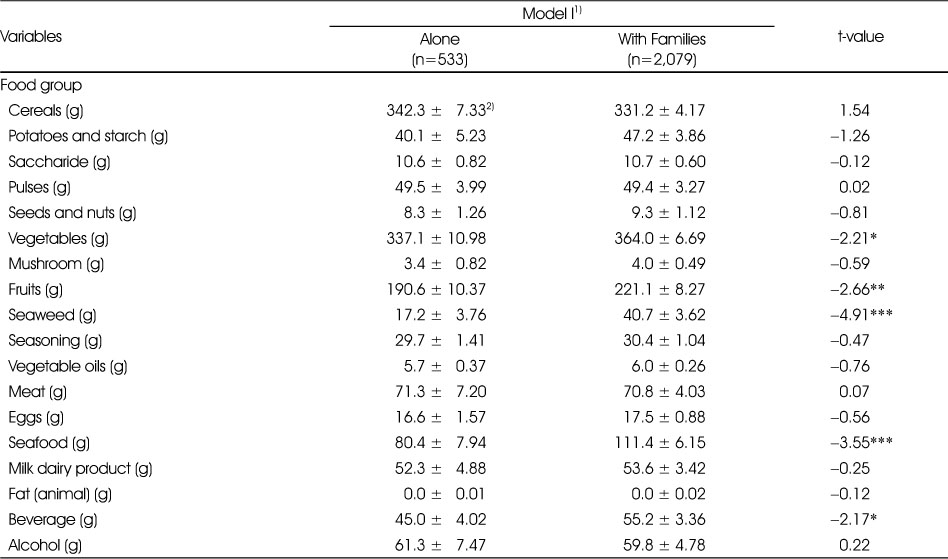References
1. Kim HG, Park MH, Kang YS, Jung HK, Jang GS, Lee HS. The elderly circumstances of dietary life, physical activity and mental health by economic activity state. J Korean Acad Health Welf Elder 2012;4(2):23–35.
2. Kim MY. Nutrient intake and food consumption of Korean elderly aged more than 65 years according to health-related quality of life: the fourth Korea national health and nutrition examination survey (KNHANES IV) 2007–2009 [dissertation] Graduate School of Chung-Ang University; 2014.
3. Statistics Korea. Population census [internet] Statistics Korea; 2015. cited 2015 Apr 20. Available from:
http://kostat.go.kr/.
4. Lim YJ, Choi YS. Dietary behaviors and seasonal diversity of food intakes of elderly women living alone as compared to those living with family in Gyeongbuk rural area. Korean J Community Nutr 2008;13(5):620–629.
5. Kim YH, Jang MR. A research on analysis of eating habits and textbook contents for efficient nutrition education of elementary school students in Gangneung city. J Korean Diet Assoc 2007;13(4):379–388.
6. Payette H, Shatenstein B. Determinants of healthy eating in community-dwelling elderly people. Can J Public Health 2005;96 Suppl 3:S27–S31.
7. Keller HH, Østbye T, Bright-See E. Predictors of dietary intake in Ontario seniors. Can J Public Health 1997;88(5):305–309.
8. Murphy SP, Davis MA, Neuhaus JM, Lein D. Factors influencing the dietary adequacy and energy intake of older Americans. J Nutr Educ 1990;22(6):284–291.
9. Kim YS. The study of the impact of the family type on the health promoting behavior and physical and mental health of elderly people. Health Soc Welf Rev 2014;34(3):400–429.
10. Shin SK, Kim HJ, Choi BY, Lee SS. Comparison of food frequency for the elderly regarding different family types, based on community health survey for 2008. Korean J Nutr 2012;45(3):264–273.
11. Locher JL, Robinson CO, Roth DL, Ritchie CS, Burgio KL. The effect of the presence of others on caloric intake in homebound older adults. J Gerontol A Biol Sci Med Sci 2005;60(11):1475–1478.
12. Jung KH. A study on the living conditions and policy issues of single elderly households Korea Institute for Health and Social Affairs; 2014. 12. Report No. 2014-22-8.
13. Han KS, Yand EJ. Evaluation of dietary habit and nutritional intake of Korean elderly: Data from Korea National Health and Nutrition Examination Survey 2013~2015. J East Asian Soc Diet Life 2018;28(4):258–271.
14. Lee JH, Kim SH. Establishment of reference intake of water for Korean adults in 2015. J Nutr Health 2017;50(2):121–132.
15. Kim HY, Lee JS, Youn JC, Chang MJ. Food and nutrient intake status of Korean elderly by degree of cognitive function. J Nutr Health 2016;49(5):313–322.
16. Kim EM, Choi MK. An analysis of food consumption patterns of the elderly from the Korea national health and nutrition examination survey (KNHANES V-1). J Korean Soc Food Sci Nutr 2013;42(5):818–827.
17. Park JE, An HJ, Jung SU, Lee YN, Kim CI, Jang YA. Characteristics of the dietary intake of Korean elderly by chewing ability using data from the Korea national health and nutrition examination survey 2007-2010. J Nutr Health 2013;46(3):285–295.
18. Kim C, Park YS. Comparing health-related behaviors, food behaviors, and the nutrient adequacy ratio of rural elderly by single-elderly families vs. extended families. Korean J Community Nutr 2000;5Suppl. :307–315.
19. Kang NE, Cho MS. A study on nutritional status and its related factors in elderly Koreans with ages. Korean J Food Nutr 1994;7(4):361–372.
20. Kang Y, Kim MY, Lee E. The relationship of perceived health status, activities of daily living and nutrition status in the community-dwelling Korea elderly. Korean J Acad Nurs 2008;38(1):122–130.
21. Kim J, Lee Y, Back JH. The association between frequency of food group consumption and functional disability in older people. J Korean Geriatr Soc 2010;14(1):25–35.
22. Thompson JL, Bentley G, Davis M, Coulson J, Stathi A, Fox KR. Food shopping habits, physical activity and health-related indicators among adults aged ≥70 years. Public Health Nutr 2011;14(9):1640–1649.
23. Kim HS, Jung GH, Jung DM, Kim SH, Lee BK. Increased calcium intake milk consumption and bone mineral density of elderly women living in Asan. J Korean Diet Assoc 2005;11(2):242–250.
24. Rurik I. Nutritional differences between elderly men and women. Ann Nutr Metab 2006;50(1):45–50.
25. Lee YJ, Kwon MK, Baek HJ, Lee SS. Comparative analysis of food intake according to the family type of elderly women in Seoul area. J Nutr Health 2015;48(3):277–288.
26. Park MS, Suh YS, Chung YJ. Comparison of chronic disease risk by dietary carbohydrate energy ratio in Korean elderly: Using the 2007-2009 Korea national health and nutrition examination survey. J Nutr Health 2014;47(4):247–257.
27. Kim SW, Kim KI. Metabolic change and nutritional supply in the elderly. Korea J Clin Nutr 2014;6(1):2–6.
28. Lee YN, Lee HJ, Lee HS, Jang YA, Kim CI. Nutritional status and revision of the elderly living alone. Korean J Community Nutr 2006;11(3):401–411.
29. Posner BM, Jette AM, Smith KW, Miller DR. Nutrition and health risks in the elderly: the nutrition screening initiative. Am J Public Health 1993;83(7):972–978.

